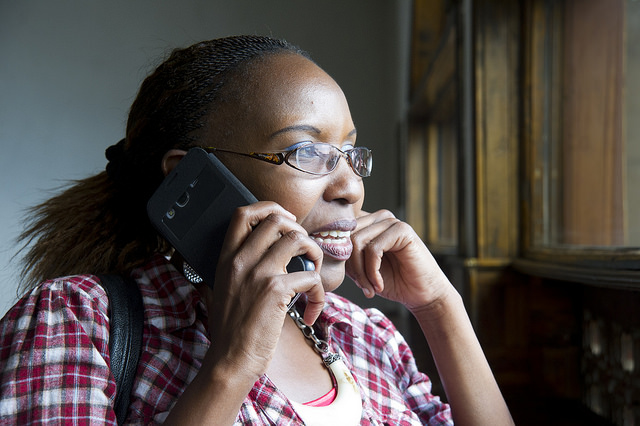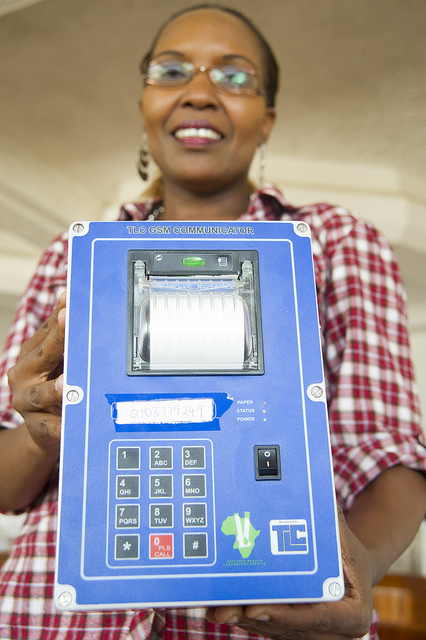 With a flick of her wrist, Dr. Cathy Mwangi opens her phone and begins dialing. It is an act repeated billions of times each day around the world, but here in Kenya, dialing a few digits can now open a lifeline.
With a flick of her wrist, Dr. Cathy Mwangi opens her phone and begins dialing. It is an act repeated billions of times each day around the world, but here in Kenya, dialing a few digits can now open a lifeline.
Launched in 2013 through the CDC Foundation, Kenya’s Mobile Post Exposure Prophylaxis (mPEP) initiative was developed through a public-private partnership with mHealth Kenya, a limited organization that links the public and private sectors in Kenya. Headed by Dr. Mwangi and supported by the CDC Foundation, the group oversees and manages mobile technology projects in the health sector.
Through mPEP, mHealth Kenya is providing support to thousands of health care workers who might have been potentially exposed to HIV at work by accident, such as a nurse, for example, who pricks her finger with a used needle. Through the existing protocol, such accidents are reported to a supervisor, who records the incident in a logbook. Within 72 hours, that healthcare provider is tested for HIV, and starts a regimen of antiretroviral therapy (ARV) medications provided as part of a health kit, proven to reduce the chances of contracting HIV. After 28 days, the health worker is re-tested. Then, the worker is tested for HIV three more times—at six weeks, three months, and six months after the accident—a lengthy process that requires careful follow up from a supervisor to ensure adherence. Through the use of the mPEP mobile system, Dr. Mwangi says, that process is now automated through a server at the Kenya National AIDS & STI Control Programme, sending text messages to those enrolled in the system to track their progress and adherence.
“The mPEP system tracks when you should go for your tests, and when you should pick up a kit,” Mwangi said. “It’s an interactive system so, when you respond to the prompts, it keeps the system active. If you ignore it, it will send you reminders.”
More importantly, says Mwangi, the system also copies the supervising health provider on all messages, so they can follow up with patients who may miss a test or drop out of the post-exposure ARV program.
“mPEP has other public health compotents. For instance, Text for Life keeps potential blood donors notified where donation centers need blood,” Mwangi said. “For example, after the Westgate (shootings), the system sent out a series of texts.”Scheduled to run until 2015, and then be handed off to the Kenyan Ministry of Health, the mPEP initiative is just one in a series of technology-based efforts mHealth is using to reshape public health in Kenya. Launched in 2012, the Text for Life initiative is helping to tap into a blood donor base in Kenya, a country where donating blood is not a common practice. While all donated blood is screened for infectious diseases like HIV, syphilis, and hepatitis A and B, those donating that blood are typically not notified if their blood does test positive. This is a gap the Kenyan government has identified in the current blood donation system. Addressing that need, Text for Life uses text messages to notify all blood donors, to see a health professional for their results, using the system as a way to get those who are positive to seek counseling and onto ARV medications. As well, the system alerts blood donors to needs that arise, either through cyclical shortages or when an acute crisis occurs.

But the application of technology does not stop there. Through the use of SMS printers, the CDC Foundation is also addressing the health needs of Kenya’s youngest citizens–babies born to mothers with HIV. Through the Polymerase Chain Reaction test (more commonly known as the heel stick) infants are tested for the HIV virus soon after birth. Because many health sites in Kenya are located in remote rural areas, the process of sending the tests to one of only six labs in the country that can process the blood work can be time consuming. The problem, says Mwangi, is that time is of the essence.
“In Kenya, children who become HIV-positive during pregnancy or childbirth need to begin treatment as soon as possible,” Mwangi said. “Without treatment, one-third of these children would die by their first birthday. So, if the test turnaround time is too long, you run the risk of being too late.”
This is where the printer comes into play. By using the SMS printer, 250 of which have been purchased by the CDC Foundation and placed in rural clinics, the results of the blood tests can be texted back to the test sites and printed out. This saves weeks of turnaround time in many cases. Once those results are received, the infants can be started on ARVs if required, greatly reducing their chances of permanently contracting the virus.
With the vast majority of Africa’s 700 million residents under the age of 30, mobile technology is a daily reality in increasingly remote areas. By tapping into that technology, the CDC Foundation, working with the President’s Emergency Plan for AIDS Relief (PEPFAR), CDC, African Ministries of Health, and groups like mHealth Kenya, is affecting real change in health care coverage, and is ultimately saving lives. It is a use of technology, says Mwangi, that keeps her engaged in the work of mHealth day after day.
“When I see how mHealth can help the public, my motivation is the impact,” Mwangi said. “I have seen this project rise from zero, when all we had was a gap, and that’s exciting.”